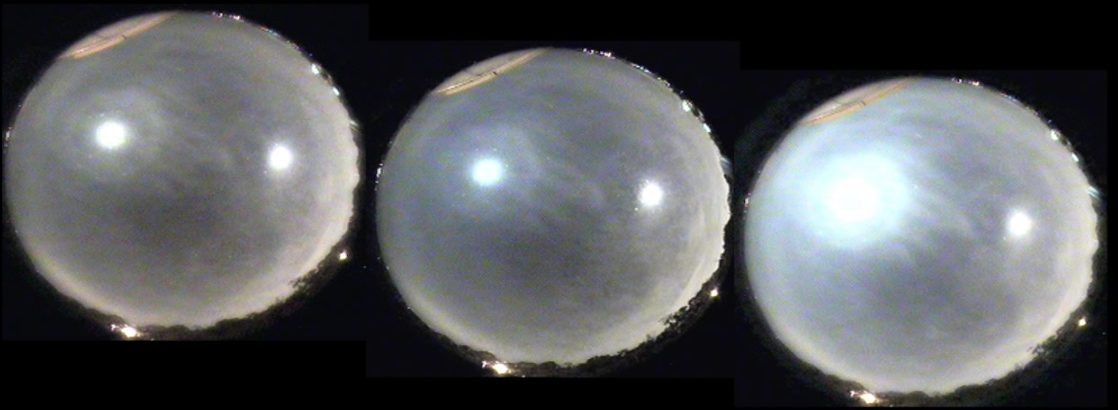Fireball Halo - OPOD
Fireball Halo - Exploring the Phenomenon
Fireball halos are a captivating atmospheric optics phenomenon that occurs when a fireball or bolide, a bright meteor, is surrounded by a halo. These mesmerizing displays of light can be witnessed in the night sky, often outshining the moon itself. In this article, we will delve deeper into the intricacies of fireball halos and explore their fascinating nature.
Fireball halos are formed due to the presence of high cirrus clouds containing an abundance of ice crystals. When these ice crystals are of the right size and quality, they can refract and reflect light, resulting in the formation of halos around celestial objects such as fireballs. It is worth noting that any light source can produce a halo if the conditions are favorable.
However, capturing a fireball halo on camera presents a significant challenge. While it has been possible to photograph halos from stars, imaging one specifically from a fireball remains an elusive feat. This rarity adds to the allure and mystique surrounding fireball halos.
To better understand fireball halos, let us examine the structure and characteristics of these fascinating optical phenomena:
-
Fireball Brightness: Fireballs are incredibly luminous, often surpassing the brightness of the moon. This extraordinary brightness contributes to the brilliance of the fireball halo, making it an awe-inspiring spectacle.
-
22° Halo: The fireball halo typically manifests as a faint halo with a radius of approximately 22 degrees around the fireball. This halo is caused by the refraction and reflection of light within the ice crystals present in the high cirrus clouds.
-
Moon Comparison: In some instances, the fireball halo may even outshine the moon itself. The combination of the fireball's exceptional brightness and the surrounding halo creates a captivating visual contrast against the night sky.
-
Crystal Size and Quality: The formation of fireball halos heavily relies on the size and quality of the ice crystals present in the cirrus clouds. These crystals act as miniature prisms, refracting and reflecting light to produce the halo effect.
-
Meteorological Conditions: Fireball halos are most likely to occur when there is an abundance of high cirrus clouds containing a sufficient number of ice crystals. These clouds often form at altitudes of 20,000 feet or higher, creating the ideal environment for the formation of halos.
-
Photographing Fireball Halos: While photographing a fireball halo remains a challenge, advancements in technology and techniques continue to improve the chances of capturing these ethereal displays. Patiently observing the night sky and being prepared to capture unexpected events can increase the likelihood of photographing a fireball halo.
-
Visual Observations: Apart from capturing fireball halos through photography, it is also possible to witness these phenomena with the naked eye. Engaging in stargazing activities during meteor showers or other celestial events can provide opportunities to witness fireball halos firsthand.
-
Educational Significance: Fireball halos not only captivate our imagination but also hold scientific significance. Studying these optical phenomena allows researchers to gain insights into atmospheric conditions, crystal formation, and the behavior of meteors as they enter Earth's atmosphere.
-
Rarity and Uniqueness: The rarity of fireball halos makes them even more special. The combination of the right atmospheric conditions, the presence of a fireball, and the alignment of ice crystals must occur simultaneously to witness this awe-inspiring spectacle.
-
Continued Exploration: As technology advances and our understanding of atmospheric optics deepens, there is still much to learn about fireball halos. Continued exploration and observation will contribute to unraveling the intricacies of these captivating phenomena, allowing us to appreciate the beauty of our natural world.
In conclusion, fireball halos are mesmerizing displays of light that occur when a fireball or bolide is surrounded by a halo. These optical phenomena rely on the presence of high cirrus clouds containing ice crystals of the right size and quality. While capturing a fireball halo on camera remains a challenge, advancements in technology and techniques provide hope for future successful observations. Fireball halos not only captivate our imagination but also hold scientific significance, allowing us to gain insights into atmospheric conditions and the behavior of meteors. As we continue to explore and observe the night sky, the allure and mystery surrounding fireball halos will undoubtedly continue to inspire us.

Fireball Halo ~ Marco Mastria captured this fireball or bolide exploding over S�o Paulo, Brazil at 01:08:03 UTC on July 7, '14.
At right is the moon surrounded by a faint 22° halo. At left the fireball which at its brightest outshines the moon - it too has its 22° halo.
All images ©Marco Mastria, shown with permission

With enough crystals of the right size and quality in high cirrus all light sources produce halos.
A challenge would be to image one (other than a pillar, that has been done) from a star.
Note: this article has been automatically converted from the old site and may not appear as intended. You can find the original article here.
Reference Atmospheric Optics
If you use any of the definitions, information, or data presented on Atmospheric Optics, please copy the link or reference below to properly credit us as the reference source. Thank you!
-
<a href="https://atoptics.co.uk/blog/fireball-halo-opod/">Fireball Halo - OPOD</a>
-
"Fireball Halo - OPOD". Atmospheric Optics. Accessed on November 15, 2024. https://atoptics.co.uk/blog/fireball-halo-opod/.
-
"Fireball Halo - OPOD". Atmospheric Optics, https://atoptics.co.uk/blog/fireball-halo-opod/. Accessed 15 November, 2024
-
Fireball Halo - OPOD. Atmospheric Optics. Retrieved from https://atoptics.co.uk/blog/fireball-halo-opod/.